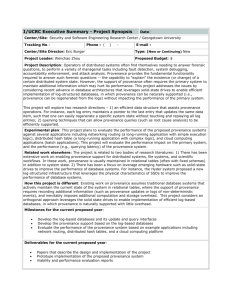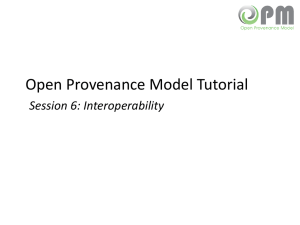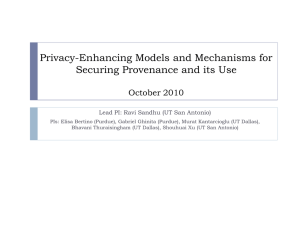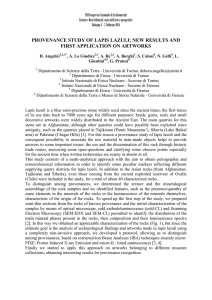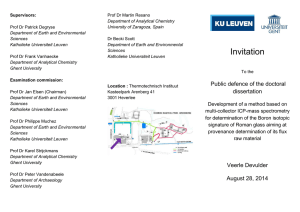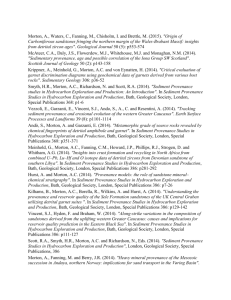bre12115-sup-0003-Appendix
advertisement
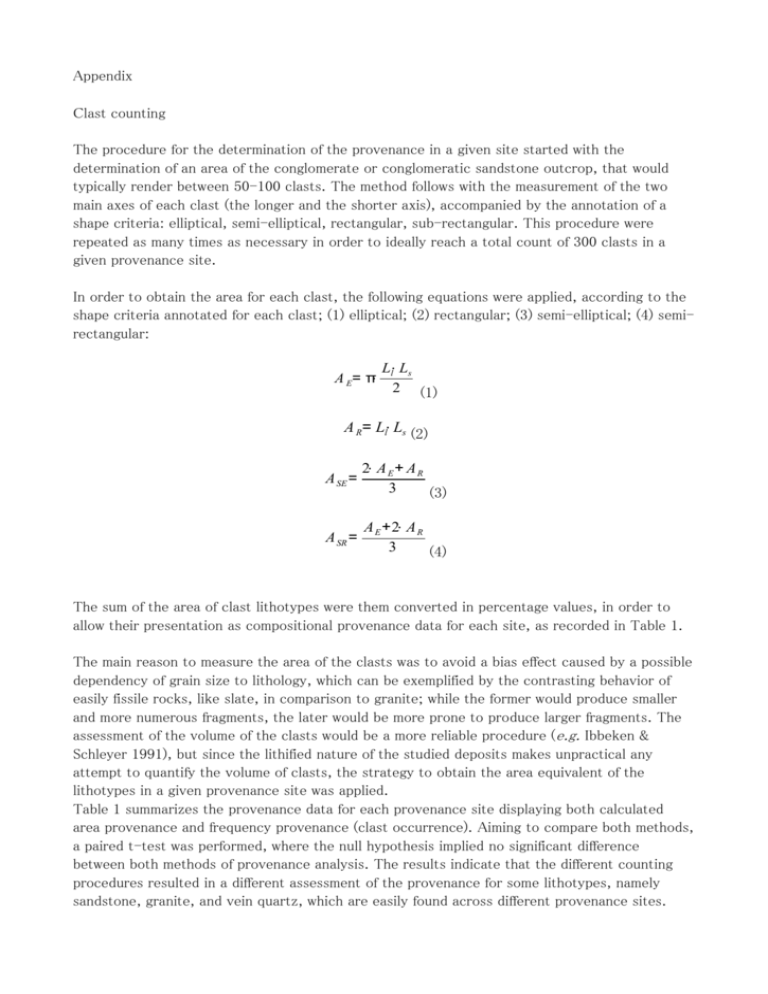
Appendix Clast counting The procedure for the determination of the provenance in a given site started with the determination of an area of the conglomerate or conglomeratic sandstone outcrop, that would typically render between 50-100 clasts. The method follows with the measurement of the two main axes of each clast (the longer and the shorter axis), accompanied by the annotation of a shape criteria: elliptical, semi-elliptical, rectangular, sub-rectangular. This procedure were repeated as many times as necessary in order to ideally reach a total count of 300 clasts in a given provenance site. In order to obtain the area for each clast, the following equations were applied, according to the shape criteria annotated for each clast; (1) elliptical; (2) rectangular; (3) semi-elliptical; (4) semirectangular: A E= π⋅ Ll⋅ Ls 2 (1) A R= Ll⋅ Ls (2) A SE = 2⋅ A E + A R 3 (3) A SR = A E +2⋅ A R 3 (4) The sum of the area of clast lithotypes were them converted in percentage values, in order to allow their presentation as compositional provenance data for each site, as recorded in Table 1. The main reason to measure the area of the clasts was to avoid a bias effect caused by a possible dependency of grain size to lithology, which can be exemplified by the contrasting behavior of easily fissile rocks, like slate, in comparison to granite; while the former would produce smaller and more numerous fragments, the later would be more prone to produce larger fragments. The assessment of the volume of the clasts would be a more reliable procedure (e.g. Ibbeken & Schleyer 1991), but since the lithified nature of the studied deposits makes unpractical any attempt to quantify the volume of clasts, the strategy to obtain the area equivalent of the lithotypes in a given provenance site was applied. Table 1 summarizes the provenance data for each provenance site displaying both calculated area provenance and frequency provenance (clast occurrence). Aiming to compare both methods, a paired t-test was performed, where the null hypothesis implied no significant difference between both methods of provenance analysis. The results indicate that the different counting procedures resulted in a different assessment of the provenance for some lithotypes, namely sandstone, granite, and vein quartz, which are easily found across different provenance sites. While most of the rock varieties found in the studied conglomerates did not bear a detectable dependency between clast size and lithology, it is important to notice that the differences in the counting methods were more sensible to lithotypes that have a tendency to produce larger and less fissile clasts. This particularity suggests that simply recording the frequency of clasts would probably result in an under representation of sedimentary and granitic sources to the basin fill. These sources comprise an important share of the source rocks bordering the studied basin, thus justifying the assessment of the provenance using methods that can compensate the bias caused by the dependency between lithology and grain size. Substitution of zero values In order to make possible the multivariate statistical analysis of the provenance data (expressed in percentage), the dataset needs to be converted to an unclosed data range, reached by the application of logarithmic ratios to the dataset (Aitchison 1986). However, the existence of compositional zeros (recorded when a given lithotype were not found in a provenance site) makes unfeasible the application of logarithmic ratios. This caveat is avoided by the substitution of null values by another defined value (Aitchison 1986, Martín-Fernandez et al. 2003). Considering that the zero values found in the provenance dataset are rounded zeros, and not absolute zeros (Martín-Fernández et al. 2003, Martín-Fernández & Thió-Henestrosa 2006), it can be said that a zero value represents a possible existence of the component, however, below the detection limit of the method. This way, in order to obtain the logarithmic ratio, a multiplicative substitution method of imputation was chosen (Martín-Fernández et al. 2003), presenting the advantage of preserving the covariance of the sample (in comparison to other substitution methods). However, instead of making use of a fixed value for the substitution of zeros, like 65% of the detection limit, as proposed by Martín-Fernández et al. (2003) and Palarea-Albaladejo et al. (2007), an alternative strategy was used, resulting in values below the detection limit of the provenance analysis (in this case, a clast with 0,25 cm2), which were specific to each provenance site. In order to substitute zeros, the chosen value should have an area equivalent to the sample error of each site, so that the imputed value would be statistically indistinguishable from zero in a given population. In this way, the substitution of zeros is based in the sample error ε of each observation equivalent to the true proportion p of the occurrence of a component present in the counting of a population n, as follows: ε= Z⋅ √ p⋅ (1− p) n (5) Where Z is the value related to the probability that ε is equivalent to p. Considering that each observation corresponds to the detection limit of the macroscopic provenance analysis (i.e., a clast with 0.5 cm length for both axis), it can be said that every square centimeter corresponds to four observations, so that: n= A⋅ 4 (6) Where n is the sample population and A corresponds to the total sum of the area of the components recorded in a given provenance site. This approach ensures that every provenance site have a particular value for the substitution of zero, which is related to the volume of fragments found in the sedimentary deposit, thus being representative of possible source areas. Inserting the equation (6) into equation (5), and using Z for a probability of 95%, the following equation is obtained: ε= 1,96⋅ √ p⋅ (1− p) A⋅ 4 (7) When ε = p, ε represents the least possible proportion of occurrence of a given component in a provenance site, which is them used to substitute the zero values in the components of the provenance analysis. Following the substitution of zeros, the dataset is them normalized to assure a fixed total range for the compositional dataset, subjecting every component that was not substituted by the ε value obtained from equation (7) to the following equations: C ' i = Ci⋅ ( 100− E ) 100 (8) E= ( ∑ x= ε) x∈C (9) Where C'i corresponds to the normalized value of the component Ci and E represents the sum of the error ε of every component in a sample space C that had the zero value substituted for the ε error. Once the dataset is free of zero values, it is ready for logarithmic transformation. As pointed out by Pawlowsky-Glahn & Egozcue (2006), there are at least three types of transformation to consider: alr – additive logarithmic ratio; ilr – isometric logarithmic ratio; and clr – centered logarithmic ratio. In each of the transformations the composition of the sample is turned to a vector. For alr and ilr the method of transformation result in vectors with one missing component, while for clr the total number of components is preserved. In this way, the chosen method for logarithmic transformation was the clr, which is essentially the logarithmic value of the product of a component by the geometric mean of the components of a given sample, as demonstrated in equation (10): clr (x 1 , x 2 , ... , x n )= [ln x1 1 , ln ( x 1∗ x 2∗ ...∗ x n)n x2 1 , ... , ln ( x1∗ x 2∗ ...∗ x n ) n xn (x 1∗ x 2∗ ...∗ x n ) 1 n ] (10) The clr method of transformation has the advantage of providing easier geologic interpretation of the data, and is particularly functional in multivariate statistics (Pawlowsky-Glahn & Egozcue 2006). Once done the logarithmic transformation, the provenance dataset is ready for multivariate statistical analysis. References AITCHISON, J. (1986) The statistical analysis of compositional data. Monographs on statistics and applied Probability: Chapman & Hall, London, 416 p. IBBEKEN, H. & SCHLEYER, R. (1991) Source and Sediment - A case study of provenance and mass balance at an active plate margin (Calabria, southern Italy). Springer-Verlag, BerlinHeidelberg. MARTÍN-FERNANDEZ, J.A. & THIÓ-HENESTROSA, S. (2006) Rounded zeros: some practical aspects for compositional data. Geological Society Special Publication, 264, Geological Society of London. PALAREA-ALBALADEJO, J., MARTÍN-FERNANDEZ, J.A. & GOMEZ-GARCIA, J. (2007) A parametric approach for dealing with compositional rounded zeros. Mathematical Geology, 39, 625-645. PAWLOWSKY-GLAHN, V. & EGOZCUE, J. J. (2006) Compositional data and their analysis: an introduction, Geological Society of London, Special Publications, 264 (1), 1-10.


